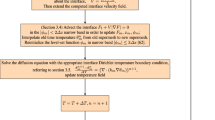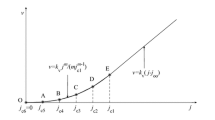Abstract
A new formulation possessing stable numerical characteristics is presented for inverse Stefan design processes. In such processes, the goal of the analysis is to design transient boundary conditions which produce the desired interfacial surface motion. This subclass of mildly ill-posed mathematical problems is amenable to the proposed solution methodology. This investigation presents a fixed-front differential formulation from which a weighted residual statement is developed. Orthogonal collocation is used to obtain numerical results illustrating the merit of imposing physical constraints in the mathematical model. These mathematical constraints can be viewed as design specifications and are available to the designer or experimentalist. The proposed methodology is flexible and can be generalized to problems involving continuous casting or crystal growth. Finally, symbolic manipulation is used for augmenting the computational methodology.
Similar content being viewed by others
References
Zabaras, N.,Inverse finite element techniques for the analysis of solidification processes, Int. J. Num. Meth. Engng.,29, 1569–1587 (1990).
Zabaras, N., Mukherjee, S. and Richmond, O.,An analysis of inverse heat transfer problems with phase changes using an integral method, J. Heat Transfer,110, 554–561 (1988).
Zabaras, N. and Ruan, Y.,A deforming finite element method analysis of inverse Stefan problems, Int. J. Num. Meth. Engng.,28, 295–313 (1989).
Zabaras, N. and Mukherjee, S.,An analysis of solidification problems by the boundary element method, Int. J. Num. Meth. Engng.,24, 1879–1900 (1987).
Zabaras, N., Ruan, Y. and Richmond, O.,Design of two-dimensional Stefan processes with desired freezing front motions, Num. Heat Transfer, Part B,21, 307–325 (1992).
Zabaras, N. and Kang, S.,On the solution of an ill-posed design solidification problem using minimization techniques in finite- and infinite-dimensional function spaces, Int. J. Num. Meth. Engng.,36, 3973–3990 (1993).
Beck, J. V., Blackwell, B. and St. Clair, C. A.,Inverse Heat Conduction, Wiley, New York (1985).
Ozisik, M. N.,Heat Conduction, 2nd ed., Wiley, New York 1993.
Frankel, J. I.,A boundary integral formulation to an inverse solidification design problem, BEM 17, University of Wisconsin 1995.
Finlayson, B. A.,The Method of Weighted Residuals and Variational Principles, Academic Press, New York 1972.
Frankel, J. I.,Cumulative variable formulation for transient conductive and radiative transport in participating media, AIAA J. Thermophys. Heat Transfer,9, no. 2, 210–218 (1995).
Katz, M. A. and Rubinsky, B.,An inverse finite element technique to determine the change of phase interface location in one-dimensional melting problems, Num. Heat Transfer,7, 269–283 (1984).
Rivlin, T. J.,The Chebyshev Polynomials, Wiley, New York 1974.
Delves, L. M. and Mohamad, J. L.,Computational Methods for Integral Equations, Cambridge University Press, Cambridge 1988.
Author information
Authors and Affiliations
Rights and permissions
About this article
Cite this article
Frankel, J.I. Constraining inverse stefan design problems. Z. angew. Math. Phys. 47, 456–466 (1996). https://doi.org/10.1007/BF00916649
Received:
Revised:
Issue Date:
DOI: https://doi.org/10.1007/BF00916649




